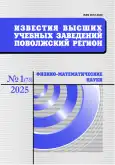Research of heat transfer and magnetohydrodynamics in the flow of liquid between two coaxial cylinders
- 作者: Solov′ev S.V.1
-
隶属关系:
- Computing Center of Far Eastern Branch of the Russian Academy of Sciences
- 期: 编号 1 (2025)
- 页面: 93-109
- 栏目: PHYSICS
- URL: https://journal-vniispk.ru/2072-3040/article/view/297181
- DOI: https://doi.org/10.21685/2072-3040-2025-1-8
- ID: 297181
如何引用文章
全文:
详细
Background. Studies of viscous fluid flow between rotating cylinders (known as the Couette flow), both experimental and theoretical, are still relevant and are widely used in technical applications (heat exchangers, nuclear and chemical reactors, separators, astrophysics). This class of problems becomes more complicated when heat exchange takes place along with hydrodynamics. The complexity of such problems increases with a joint consideration of heat exchange and the flow of viscous conductive fluid between cylinders rotating with different angular velocities. Further research is needed to study and better understand such complex processes, which will serve to clarify the mathematical models of heat exchange and magnetohydrodynamics. The paper considers heat exchange and magnetohydrodynamics of fluid (for a given velocity field) between two rotating coaxial cylinders. The purpose of the work is to study the influence of angular velocities of cylinder rotation, Joule heat dissipation, internal heat sources/sinks, cylindrical layer thickness and magnetic Reynolds number on the temperature and magnetic induction fields of liquid in the cylindrical layer. Materials and methods. In dimensionless form, the problem of heat exchange and flow of electrically conductive liquid between two rotating cylinders is solved numerically in a cylindrical coordinate system. The control volume method (Patankar method) is used to solve the problem. Results. The influence of the velocity field, internal heat sources/sinks, Joule heat dissipation, cylindrical layer thickness on the temperature fields, radial and angular components of the magnetic induction of an electrically conducting liquid between two coaxial rotating cylinders is investigated. It is found that changing the direction of rotation of the cylinders leads to a change in the type of extremum of the angular component of magnetic induction. Reducing the magnetic Reynolds number increases the intensity of heat exchange in the liquid. Conclusions. The results obtained can be used both in the study of thermal and magnetohydrodynamics processes and in the design of power and chemical devices, separators, instruments and installations.
作者简介
Sergey Solov′ev
Computing Center of Far Eastern Branch of the Russian Academy of Sciences
编辑信件的主要联系方式.
Email: solovjovsv@rambler.ru
Doctor of physical and mathematical sciences, professor, leading researcher
(65 Kim Yu Chen street, Khabarovsk, Russia)参考
- Elkhazen M.I., Hassen W., Gannoun R., Hussein A.K. and Borjini M.N. Numerical study of electroconvection in a dielectric layer between two cofocal elliptical cylinders subjected to unipolar injection. Journal of engineering physics and thermophysics. 2019;92(5):2358–2370.
- Kashevskiy S.B., Kashevskiy B.E., Khudoley A.L. Experimental model for studying the dynamics of magnetic dispersion in a gradient magnetic field. Inzhenerno-fizicheskiy zhurnal = Engineering and physics journal. 2018;91(1):184–194. (In Russ.)
- Ahmed N. Heat and mass transfer in MHD poiseuille flow with porous walls. Journal of engineering physics and thermophysics. 2019;92(1):128–137.
- Borisevich V.D., Potanin E.P. Magnetohydrodynamics and heat transfer in rotating flows. Inzhenerno-fizicheskiy zhurnal = Engineering and physics journal. 2019;92(1):174–181. (In Russ.)
- Fedorov S.V. Magnetic field enhancement in jet flows of conducting materials: collision of two jets with a magnetic field. Inzhenerno-fizicheskiy zhurnal = Engineering and physics journal. 2021;94(3):675–685. (In Russ.)
- Belabid J. Hydromagnetic natural convection from a horizontal porous annulus with heat generation or absorption. Journal of engineering physics and thermophysics. 2021;94(4):960–965.
- Pavlyukevich N.V., Shnip A.I. Modeling heat transfer in the core of a nuclear power reactor in the presence of perturbations of hydrodynamic and energy parameters. J. Eng. Phys. Thermophys. 2022;95(1):29–36.
- Perminov A.V., Nikulin I.L. Mathematical model of heat and mass transfer processes and magnetic field diffusion in an induction furnace. Inzhenerno-fizicheskiy zhurnal = Engineering and physics journal. 2016;89(2):388. (In Russ.)
- Volker T., Odenbach S. Thermodiffusion in magnetic fluids. Journal of Magnetism and Magnetic Materials. 2005;289:289–291.
- Grinkrug L.S., Solov'ev S.V., Tsoy R.I. Modeling heat transfer of an electrically conductive liquid in a cylindrical layer. Vestnik Priamurskogo gosudarstvennogo universiteta im. Sholom-Aleykhema = Bulletin of Sholem Aleichem Primorsky State University. 2013;(2):36‒42. (In Russ.)
- Aristov S.N., Pukhnachev V.V. On the equations of rotationally symmetric motion of a viscous incompressible fluid. Doklady Akademii nauk = Reports of the Academy of Sciences. 2004;(394):611–614. (In Russ.)
- Aristov S.N., Gitman I.M. Viscous flow between two moving parallel disk: exact solutions and stability analysis. J. Fluid Mech. 2002;464:209–215.
- Landau L.D., Lifshits E.M. Teoreticheskaya fizika: ucheb. posob. T. VIII. Elektrodinamika sploshnykh sred. 4-e izd., stereot. = Theoretical physics: textbook. Volume 8. Electrodynamics of continuous media. The 4th edition, stereot. Moscow: Fizmatlit, 2005:656. (In Russ.)
- Patankar S. Chislennye metody resheniya zadach teploobmena i dinamiki zhidkosti: per. s angl. = Numerical methods for solving problems of heat transfer and fluid dynamics: translated from English. Moscow: Energoatomizdat, 1984:152. (In Russ.)
- Landau L.D., Lifshits E.M. Teoreticheskaya fizika: ucheb. posob. T. VI. Gidrodinamika. 5-e izd., stereot. = Theoretical physics: textbook. Volume 6. Hydrodynamics. The 5th edition, stereot. Moscow: Fizmatlit, 2001:736. (In Russ.)
补充文件









